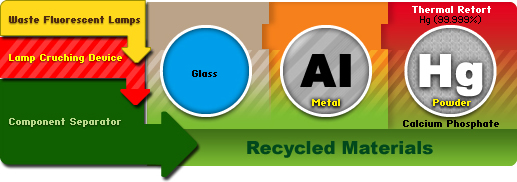Fluorescent Lamp Recycling

This operation involves processing and physical separation of fluorescent lamps
containing mercury. The lamps will be separated into the streams of fluorescent
lamps end caps, clean glass, phosphor powder, and, eventually, elemental
mercury. The source of these spent fluorescent lamps include households,
schools, commercial and industrial sites, and the manufacturers of these
lighting components. Fluorescent lamps will be transported to the MTI facility
in accordance with local, state, and federal regulations. The containers will
then be off-loaded from the vehicles and stages prior to processing.
After temporary storage, the lamps will be processed in the equipment and
physically separated into the components mentioned earlier. The equipment
consists of a crusher, separator, particle and vapor filtration systems,
material handling systems, and a program logic control system. The resulting
materials generated from this activity (end caps, glass, phosphor powder) are
transported off site for further processing, recycling, or disposal.
Crush and Separation
Whole lamps enter the recycling process and undergo the initial glass breakage.
The material is further crushed by rotating drums and moved to a trommel
system. The lamp components are separated by the trommel system and each
co-product is deposited into a container. The end caps are collected, sampled,
analyzed for mercury content, and shipped to an off-site metals recycling
facility for their aluminum content.
The glass is sampled and analyzed for mercury and sent for recycling or
disposal, depending on the current market. The phosphor powder is further
separated for glass fines and collected in containers and shipped off-site for
retort. The ferrous portion of the lamps, the filaments, are removed by a
magnetic separator and sent for retort.
The mercury recovered from the retorted co-products is then triple distilled
and sold on the domestic market as Technically Pure Mercury.
An industrial blower maintains negative pressure across the entire lamp
processing system. The air drawn through the system is cleaned of all residual
dust/powder by a series of nine baghouse cartridge filters. These filters are
automatically back flushed on a regular basis to prevent powder build-up.
Dust/powder-free air then passes through the carbon filtration system prior to
discharge.
Thermal Recovery Unit
The powder separated by the LSS1 is fed into the retort unit. With the
application of heat, the mercury vaporizes free from the powder. The vaporized
mercury is then condensed back into a liquid. This commodities grade of mercury
is collected for further processing through the Triple Distillation Process.
Triple Distillation
The mercury from the retort process is distilled three times to remove other
impurities. The mercury is then sampled and analyzed by an independent
metallurgical laboratory for appearance and certification that it is at least
99.99 percent pure mercury. Upon verification of purity, the Technically Pure
Mercury product is then packaged according to individual customer
specifications and sold as a product to companies that manufacture mercury
salts, mercury-containing devices, or utilize the mercury in electronics and
various research and development applications.